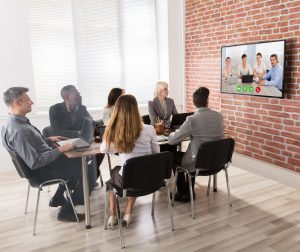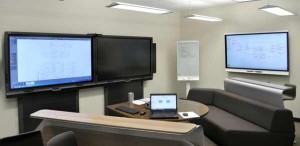The Meeting, Made New
 Business managers know, for the most part, that meetings aren’t universally loved. Meeting structure has been the subject of extensive research and experimentation for that very reason. The hope being that there is a perfect way to get people in a room together and be productive. Of course, people are never that simple, so there is no magic fix for the boring meeting problem. What there is, though, is plenty of technology that can make meetings more effective and engaging by degrees. When used in concert, the effect can be impressive, resulting in more effective, more timely and more enjoyable collaboration. So how are A/V integrators winning the battle against the worn-out meeting approach? It’s a combination of technology and expertise. For example, every modern conference room should feature these A/V solutions for maximum results:
Business managers know, for the most part, that meetings aren’t universally loved. Meeting structure has been the subject of extensive research and experimentation for that very reason. The hope being that there is a perfect way to get people in a room together and be productive. Of course, people are never that simple, so there is no magic fix for the boring meeting problem. What there is, though, is plenty of technology that can make meetings more effective and engaging by degrees. When used in concert, the effect can be impressive, resulting in more effective, more timely and more enjoyable collaboration. So how are A/V integrators winning the battle against the worn-out meeting approach? It’s a combination of technology and expertise. For example, every modern conference room should feature these A/V solutions for maximum results:
1. An interactive display – This is the showpiece, the hub of the wheel. Interactive displays are modern, sleek pieces of technology that enhance collaboration in a variety of ways. First, they are just plain beautiful to behold, as displays like the Clevertouch support 4K ultra HD resolution, so they produce incredibly detailed images and bright, popping colors. Any meeting that involves media will be more interesting to behold on an interactive display.
But, of course, the true power of an interactive display is not its ability to show off images, but its interactivity. At its simplest, interactive displays facilitate meeting proceedings because the presenter can move through and annotate over meeting materials with just a few gestures. Interactive displays can be controlled from around the room, so the presenter can move, and some are equipped with onboard storage and a web browser, so if anything needs to be referenced on the fly, there is an entire internet out there to help with that.
Interactive displays are key to true collaboration, and though they are work in any setting, they are ideal for small team collaboration. Anyone can get up from their chair and start making notes on the board. It encourages people to sketch out their thoughts right away, which is the kind of meeting flow that works best for small teams with great rapport.
2. Video conferencing – Video conferencing has come a long way in a short time, to the point where remote conferencing is just as effective as a face to face meeting. Modern video conferencing systems, paired with a stable network, are efficient enough to reliably produce HD quality video, high quality audio and at strong framerates. The rapid improvement of video conferencing technology has been a financial boon to companies as it eliminates much of the travel that employees used to be subjected to. Now, those employees can execute their meetings with partners and clients from the conference room, and keep their luggage in the closet.
Video conferencing can be scaled up or down to any company’s needs. A simple room system is a modest commitment, is easy to use, and provides the quality A/V experience that companies demand from their conferencing system. But if a business plans on making extensive use of their new conferencing solution, an immersive, full room system may make more sense. An immersive solution integrates all of the system components into the room’s architecture and design, so components are hidden until they are needed. Meeting members merely sit down, activate the system from a control panel, enter the conference and begin speaking. An immersive solution is custom-built for the room, so there is never any amateurish issue with people not remaining in frame or speaking out of range of the microphone. It’s the ultimate in video conferencing, and immediately conveys the kind of professional tone that every corporation wants.
3. Improved audio system – It’s tough to manage video conferences without enhanced audio. Relying on the display’s onboard speakers and microphone won’t work in most settings, and the audio on the other end will sound tinny. Fortunately, integrators are experts at tweaking audio for a particular room, using acoustic diagramming as the starting point.
Audio solutions consist of inputs (microphones), and outputs (the speakers). Both are tied to an audio controller that corrals all of the signals and processes them for maximum clarity. Microphone and speaker placement are critical to an optimally-functioning audio system, and this is what A/V integrators will focus on when setting up an audio system.
4. Room control system – Sophisticated A/V solutions merit sophisticated room controls, and these can be integrated into the space in one of many ways. They can be mounted to the table, installed into the wall, hidden discreetly behind a panel, or in any other place that a client prefers. Room controls allow for multiple levels of access, so technical staff can configure and troubleshoot from the panel, while others can be given just on/off access to the room equipment.
A control system can be finely tuned for the client’s needs, so a single button press can do as much as switching on all A/V equipment, automatically configure that equipment, lower the blinds, bring up or down the lights, set the audio volume, and even lock the doors prior to the meeting start. This can shave off several minutes from every meeting, and that’s valuable time.
5. Room booking – Room booking solutions come with a hardware and software component. The hardware is installed outside of every conference room (or any meeting room) and comes with a small display panel. The panel cycles through the day’s scheduled meetings and alerts others to when a room is occupied and a meeting is in progress.
On the software side, office managers can schedule meetings on behalf of others, list the participants, contact those participants en masse so that they are alerted to the meeting, and adjust meeting times or locations as they change. This scheduling information is made public to all involved, so everyone knows when the meeting is, where it is, and what it will cover.
Clearly, the modern conference room is an impressive showcase of various technologies, all of them aimed at making meetings more interesting, more impactful and more efficient. But what about companies that prefer cozier forms of collaboration? For those businesses, huddle rooms are the answer.Huddle Up and Talk It Out
 Huddle rooms are coursing through the professional world like a wildfire, but unlike many corporate trends, this one has staying power. That’s because they appeal to most people’s preference of collaborating in smaller groups. As such, huddle rooms are a welcome addition to most corporations, and they quickly prove themselves to be an effective approach to meetings.
The huddle room is much smaller than a traditional conference room, so two or three (or more) huddle rooms can take up the same footprint as a full size conference room. Each one comes equipped with a handful of A/V technologies, including:
Huddle rooms are coursing through the professional world like a wildfire, but unlike many corporate trends, this one has staying power. That’s because they appeal to most people’s preference of collaborating in smaller groups. As such, huddle rooms are a welcome addition to most corporations, and they quickly prove themselves to be an effective approach to meetings.
The huddle room is much smaller than a traditional conference room, so two or three (or more) huddle rooms can take up the same footprint as a full size conference room. Each one comes equipped with a handful of A/V technologies, including:
- An interactive display
- A video conferencing system
- A small table and set of chairs
- Integrated cabling for connectivity purposes
- Everyone is on the same level – Huddle rooms are about inclusivity, as no one is standing up and lording over everyone else. No one is at the head of the table. Everyone is sitting around the table as equals, so everyone is encouraged to remain active and participate in the meeting. And because there are only a few people involved, there’s less pressure to say everything perfectly when the brainstorming happens, helping collaboration along further.
- They bring teams closer together – Every company wants their teams to get along as people as well as coworkers. Huddle rooms put people in the kind of environment where speaking is easy and team members become familiar with each other. Camaraderie is a natural byproduct of this meeting arrangement.
- Space is utilized more efficiently – Huddle rooms come with a tiny footprint, so they make the most out of every square foot. With office rent as high as it is today, space is at a premium. Huddle rooms help alleviate the burden.
- Rapid fire collaboration – Huddle rooms are designed to get in and out of in a hurry, so they are ideal for teams where frequent, but brief, collaboration is preferred. Having a huddle room on hand for this purpose can keep the conference room from being tied up constantly, while also affording team members the chance to collaborate in private.



